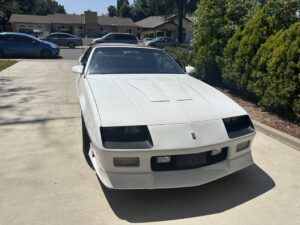
This 1991 Chevrolet Camaro VIN Verification was done by our team member in Riverside, Ca. on 4/25/2025

This 1991 Chevrolet Camaro VIN Verification was done by our team member in Riverside, Ca. on 4/25/2025
The 1991 Chevrolet Camaro marked one of the final years of the Camaro’s third generation—a sharp, aggressive design era that began in 1982. With a sporty wedge shape, pop-up headlights, and a loyal performance following, the 1991 Camaro blended classic muscle car DNA with evolving ’90s styling. It was a favorite among younger drivers and performance enthusiasts alike, offering a mix of affordability, power, and street presence.
The third-generation Camaro debuted in 1982 and represented a major shift from the heavier second-generation models. By 1991, the Camaro was benefiting from a decade of refinement. This model year saw some fresh styling tweaks, including a new ground effects package and revised front and rear fascias. The legendary IROC-Z trim was discontinued after 1990, and the Z28 returned to reclaim its spot as the top performance trim.
The 1991 Camaro offered a range of powertrains catering to different budgets and performance needs:
2.5L Iron Duke I4 – 90 hp (Base model; rarely seen)
3.1L V6 – 140 hp (RS and mid-level trims)
5.0L V8 (TBI) – 170 hp (Available in Z28)
5.0L V8 (Tuned Port Injection) – 230 hp (High-output Z28 option)
5.7L V8 (Tuned Port Injection) – 245 hp (Optional in Z28 coupe)
Transmissions included a 5-speed manual and a 4-speed automatic. The Z28, especially with the 5.7L TPI, was a true performer, capable of sub-6-second 0–60 mph times and strong quarter-mile pulls.
The 1991 Camaro had a bold, aerodynamic look, highlighted by:
Pop-up headlights
Integrated body-colored ground effects (new for 1991)
Updated rear spoiler design (wraparound-style for Z28)
Optional T-tops and rear hatch glass
Inside, the cockpit featured a driver-oriented dash, bucket seats, and analog gauges. While the interior materials were simple by modern standards, the Camaro offered an unmistakably sporty vibe.
The 1991 Camaro was offered in three main trims:
Base – Minimal features, 4-cylinder or V6 engines
RS (Rally Sport) – Sporty appearance package, V6 or V8 options
Z28 – Top performance trim, TPI V8s, performance suspension, fog lights, and dual exhaust
Special options included:
Heritage Package – Retro stripes and styling nods to early Camaros
1LE Performance Package – A rare track-focused version with upgraded brakes, suspension, and deleted A/C (aimed at racing)
Safety features in the 1991 Camaro included:
Driver-side airbag (first introduced in 1990)
3-point seat belts
Anti-lock brakes (optional on some trims)
Standard side mirrors and basic crash protection
Tech was fairly basic but included features like power windows, cruise control, cassette player or optional CD, and power mirrors depending on trim.
Fuel economy varied depending on the engine:
I4 and V6 models: 18–25 mpg (city/highway)
5.0L V8: Around 16–24 mpg
5.7L V8: Closer to 15–22 mpg
For a muscle coupe, these numbers were fairly respectable, especially compared to earlier generations.
In 1991, the Camaro went head-to-head with:
Ford Mustang GT
Pontiac Firebird (sibling model)
Dodge Daytona
Toyota Supra (for performance comparisons)
The Camaro Z28 offered more horsepower than the Mustang GT and was cheaper than the Supra, making it a strong value pick for performance fans.
Original MSRP for the 1991 Camaro ranged from:
Base model: ~$10,000
RS: ~$12,000
Z28: ~$15,000–$17,000 depending on options
Today, values vary:
Clean RS or base models: $6,000 – $12,000
Z28 models (TPI V8s, low mileage): $15,000 – $25,000
Rare 1LE versions or show-quality restorations: $25,000+
Recognized as one of the most iconic third-gen Camaros
The 1LE variant earned respect in SCCA and amateur racing circles
A favorite in pop culture and the tuner scene through the 1990s and early 2000s
Need a VIN Verification? We are licensed to complete the REG 31 form. Call to get your car, truck or motorcycle verified today!
© 2025 QUICK VIN VERIFICATION. All rights reserved.